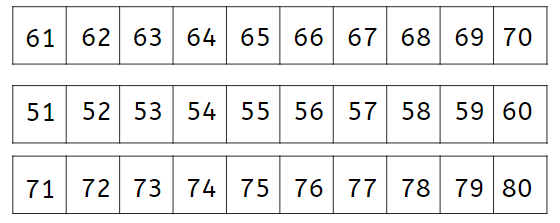Myths about teaching can hold you back
- Year 1
Crossing the tens boundary counting forwards
I can count forwards from 1 to 100, crossing the tens boundary
- Year 1
Crossing the tens boundary counting forwards
I can count forwards from 1 to 100, crossing the tens boundary
These resources were made for remote use during the pandemic, not classroom teaching.
Switch to our new teaching resources now - designed by teachers and leading subject experts, and tested in classrooms.
Lesson details
Key learning points
- The numbers from 0 to 100 have patterns that can help us to count across the tens boundary.
- They are arranged differently on a number track and on a one hundred square.
- We can count the numbers in two ways.
- When a whole number ends in a 9, it is always followed by a decade number.
Keywords
Tens boundary - This is where the pattern of counting changes at the start of the number to show a new decade has started.
Decade number - This is a multiple of 10 which marks the tens boundary where the pattern of counting changes.
Common misconception
Confusion between the number after 29, 39 etc. so saying 29,20 or twenty-none, twenty -ten.
Explicitly look at the numbers that follow a number ending in 9 using stem sentence to support.
To help you plan your year 1 maths lesson on: Crossing the tens boundary counting forwards, download all teaching resources for free and adapt to suit your pupils' needs...
To help you plan your year 1 maths lesson on: Crossing the tens boundary counting forwards, download all teaching resources for free and adapt to suit your pupils' needs.
The starter quiz will activate and check your pupils' prior knowledge, with versions available both with and without answers in PDF format.
We use learning cycles to break down learning into key concepts or ideas linked to the learning outcome. Each learning cycle features explanations with checks for understanding and practice tasks with feedback. All of this is found in our slide decks, ready for you to download and edit. The practice tasks are also available as printable worksheets and some lessons have additional materials with extra material you might need for teaching the lesson.
The assessment exit quiz will test your pupils' understanding of the key learning points.
Our video is a tool for planning, showing how other teachers might teach the lesson, offering helpful tips, modelled explanations and inspiration for your own delivery in the classroom. Plus, you can set it as homework or revision for pupils and keep their learning on track by sharing an online pupil version of this lesson.
Explore more key stage 1 maths lessons from the Pattern in counting from 20 to 100 unit, dive into the full primary maths curriculum, or learn more about lesson planning.

Licence
Prior knowledge starter quiz
6 Questions
Q1.Which of these rows from the one hundred square should come last when counting forwards?

Q2.Sam is counting the rows on the one hundred square backwards. They count the forties, the thirties. Which row will they say next?

Q3.Sort these numbers in the order you would say them when counting forwards along the row of the one hundred square.
Q4.Sort these numbers in the order you would say when counting backwards along the row of the one hundred square.
Q5.Sam is counting along the sixties row. Which number will they say next?

Q6.Numbers can be said in different ways. Match the numbers to the correct way to say it.
3 tens 5
5 tens 3
2 tens 8
8 tens 2
Assessment exit quiz
6 Questions
Q1.On the one hundred square, a number ending in a 9 is always followed by a __________.
Q2.Match the rows on the one hundred square to the correct decade numbers on that row.
40
50
60
Q3.Lucas is counting forwards and taps this number on his Gattegno chart. What number will he tap next?

Q4.Andeep is counting. What number will he say next?

Q5.When counting forwards, which counting sequence is correct?
Q6.Look at the picture. I’m thinking of a number that ends in 4. When I count forwards, I say it after 40. What is my number?



